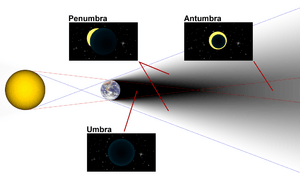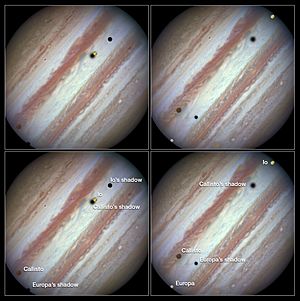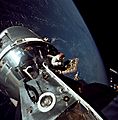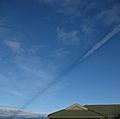Shadow facts for kids
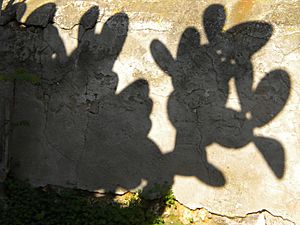

A shadow is a dark area that appears on a bright surface. It forms when an object blocks light from a light source. The shape of a shadow, also called a silhouette, will always match the shape of the object creating it.
The way a shadow looks can change a lot. This depends on the type of light source and how many there are. For example, a single, small light source creates a simple, clear shadow. But if the light source is large or there are many lights, the shadow can look very different.
Contents
Understanding Different Shadow Types
When light comes from a very small point, it makes a simple, dark shadow called an umbra. This is the darkest part of a shadow.
However, if the light source is larger, like the sun or a big lamp, the shadow becomes more complex. It can have different parts:
- The umbra is still the darkest part, where all the light is blocked.
- The penumbra is a lighter, fuzzy area around the umbra. Here, only some of the light is blocked.
- The antumbra is a bright ring that can appear beyond the umumbra, where the object is completely within the light source.
The bigger the light source, the softer and less clear the edges of the shadow become. If the light is very spread out, like on a cloudy day, you might not see many shadows at all.
Shadows in Space
The terms umbra, penumbra, and antumbra are often used to describe shadows made by objects in space. For example, when the Earth or Moon blocks sunlight, they create these types of shadows.
Only a few space objects can cast shadows that we can see from Earth. These are mainly the Sun, the Moon, and sometimes Venus or Jupiter under the right conditions.
- A lunar eclipse happens when the Earth casts its shadow onto the Moon. This makes the Moon look dark or reddish.
- A solar eclipse happens when the Moon casts its shadow onto the Earth. This can make the sun appear partly or completely covered.
Nighttime on a planet is simply the shadow that the planet casts on itself. The side of the planet facing away from its star is in shadow, causing darkness.
How Shadows Change During the Day
The sun creates shadows that change a lot throughout the day. The length of a shadow depends on how high the sun is in the sky.
- In the morning and evening, when the sun is low near the horizon, shadows can be very long.
- Around midday, when the sun is high overhead, shadows are short and appear right under objects.
People in ancient times used these changing shadows to tell time or find their way, especially in places like deserts.
Why Shadows Can Look Blue
During the day, a shadow cast by sunlight often has a slight bluish tint. This happens because of something called Rayleigh scattering. This is the same reason why the sky looks blue!
The object blocking the sun stops the direct sunlight. However, the light from the sky, which is blue because of how the atmosphere scatters blue light, can still reach the shadow area. This makes the shadow appear a bit blue.
Shadows and Their Cultural Meanings
Shadows have often appeared in stories and beliefs across different cultures. Sometimes they are seen as mysterious or even a bit scary.
- In some old stories, a shadow that moved on its own was thought to be like a ghost.
- The fear of shadows is called "sciophobia" or "sciaphobia."
- In Hindu mythology, Chhaya is the goddess of shadows.
Shadows are sometimes connected with darkness or evil in folklore. For example, in some stories, shadows that come to life are evil beings trying to control the people they reflect.
Ancient Egyptians believed that a person's shadow, which they called "šwt" (shut), held a part of that person's spirit. They thought this because the shadow was always with them. Because of this belief, statues of people and gods were sometimes called shadows.
Images for kids
-
Steam phase eruption of Castle Geyser in Yellowstone National Park casts a shadow on its own steam. Crepuscular rays are also visible.
-
Fog shadow of the south tower of the Golden Gate Bridge
-
Sutro Tower casts a 3D fog shadow
-
Clouds, and shadows over the Mediterranean Sea
-
Shadow cast by vapor trail of passing aircraft
See also
 In Spanish: Sombra para niños
In Spanish: Sombra para niños


